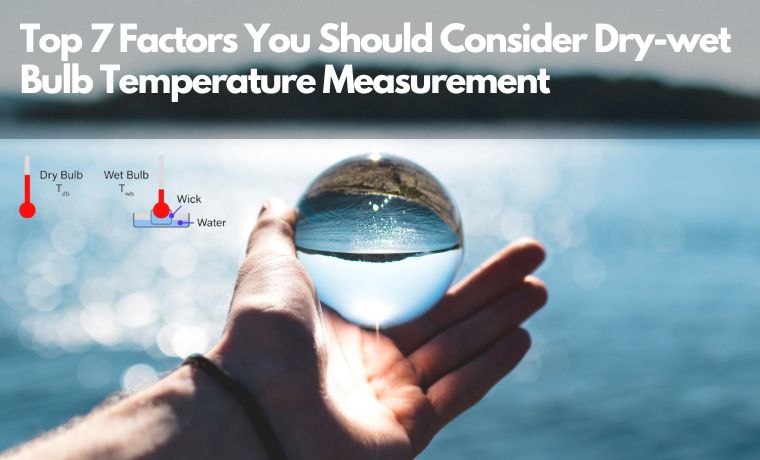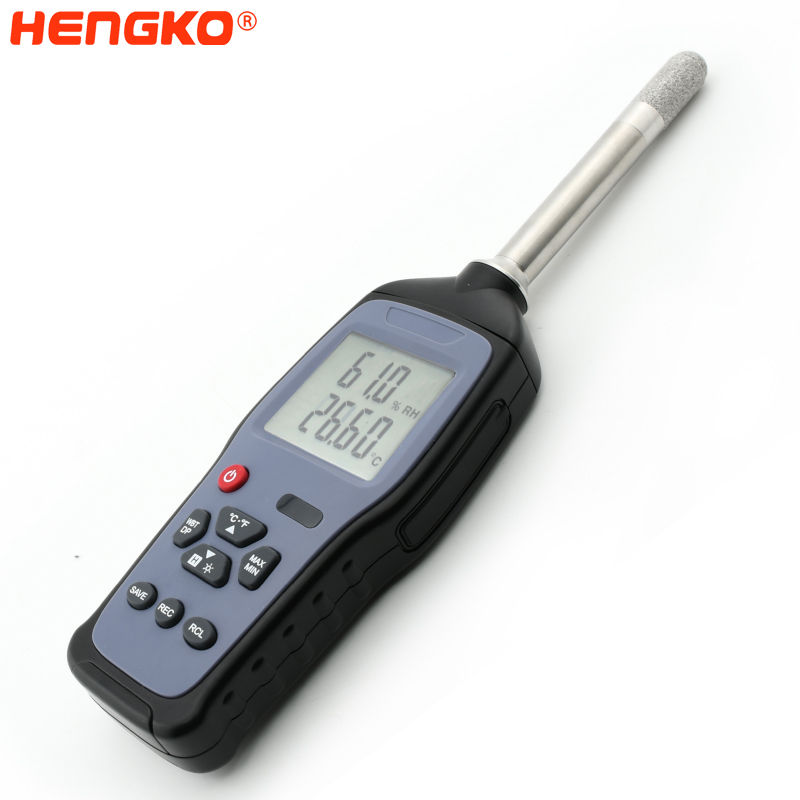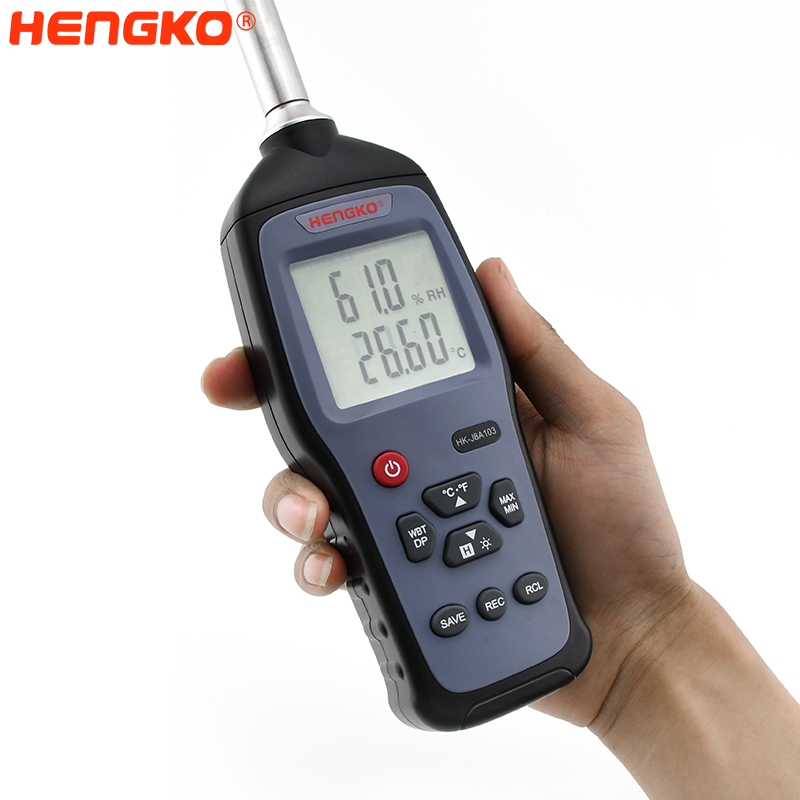
Dry-wet bulb temperature measurement is a common and widely accepted technique for controlling relative humidity in an ambient chamber.
1. First: the advantages and disadvantages of dry-wet bulb temperature measurement, While wet and dry bulb measurement technology has a good theoretical foundation, the problem is that it is simple in appearance, causing many users to forgo the care and precision required to obtain accurate results. We'll explore the most commonly overlooked requirements and other issues below.
A.) Advantages: It has simple and basic measurements; Low price; If the operation is correct and consistent, it has good stability; Withstand condensation without damage, and other advantages.
B.) Disadvantages: The drawbacks are also obvious: uncertainty is high; Requires training and some skill to use and maintain; Must calculate the result; Need a large number of air samples; The process adds water vapor to the sample and many variables lead to increased uncertainty; Disregard the basic requirements of technology.
2. Second: in practice, people tend to ignore the following requirements of wet and dry bulb technology:
A.) Hygrometer coefficient: This is used to establish a hygrometer chart that converts wet and dry bulb temperature readings into relative humidity. This coefficient must be determined for each specific design of the hygrometer, and in particular for each design of the wet bulb.
B.) Atmospheric pressure: Humidity diagrams are usually valid at "standard" atmospheric pressure and need to be corrected for other pressures.
3. Thermometer matching:
Dry-wet Bulb Temperature Measurement should not only be accurate but also match, to minimize the temperature drop reading (or temperature difference) error.
If the error is too large, it is meaningless for the accuracy and guidance of the measurement results.
Constant HENGKO high precision handheld temperature and humidity calibration instrument temperature accuracy: ±0.1℃ @25℃, can also measure dry and wet bulb (-20-60℃ range).
4. Interference During Measurement
In the ambient chamber, improper installation of the dry-wet bulb thermometer may lead to measurement errors.
This can occur when thermometers are installed too close to a wet air source (water supply from wet balls, steam ejectors, etc.). Errors can also occur when the thermometer is too close to the chamber wall.
5. Poor Handling and Maintenance
Proper handling and frequent maintenance are major requirements of wet and dry bulb technology. Poor measurement is usually caused by: Dirty wick: Do not touch the wick with your fingers. The new wick should be immersed in distilled water to wash away any contaminants.
In the environmental chamber, the wick is continuously ventilated and tends to become dirty after a period of time. This is probably the most worrying aspect of wet and dry bulb technology from a maintenance standpoint. Wicks not pulled out properly: Wicks should be fully covered by the wet-bulb thermometer to minimize errors due to heat conduction along the thermometer rod. The wick must also be in close contact with the thermometer's surface.
Wicks not very wet: Wicks that are too old or have been dried may not provide enough water. Properly wetted wicks should have a smooth appearance.
6. Typical Precision of the Technology
Most of the problems mentioned above directly affect the accuracy of dry-wet bulb temperature measurement technology. Specifically, most of the errors occurred in the wet-bulb temperature and temperature drop measurements.
Considering only the uncertainty of temperature measurements and humidity coefficients, ASTM standard #E 337-02 (2007) indicates an error range of 2 to 5 % RH for both wet and dry bulb equipment. The error of 2% RH corresponds to the temperature drop error of 0.1℃ and the dry bulb temperature error of 0.2℃, while the error of 5% RH corresponds to the temperature drop error of 0.3℃ and the dry bulb temperature error of 0.6℃ - bulb temperature. The most important factor is the accuracy of temperature drop measurements.
Also Considering many other potential sources of error, the effective accuracy of wet and dry bulb installations installed in most environmental chambers is no more than 3 to 6 % RH. Errors tend to be greatest at low humidity and low temperatures, where readings are usually too high.
7. Wet Ball and Dry ball Technology operation restrictions
In addition to accuracy limitations, wet-ball and dry-ball techniques have other limitations that may be important in the context of an environmental chamber: No measurement below freezing. Add water to the environment (problems with chambers operating at low humidity).
Slow response and therefore poor control characteristics. Because of the quality of the wet-bulb thermometer and wick, the wet-bulb temperature responds slowly to changes in humidity. The slow response to temperature changes is due to the water supply taking time to get used to. A water supply is needed to support microbial growth. Calibration can be difficult. In summary, if you are still measuring wet and dry bulb temperatures with old wet and dry bulb equipment, the error can be significant.
HENGKO HK-HG972 handheld temperature and humidity calibration instrument is a high precision temperature and humidity measurement equipment that can measure wet and dry bulb, dew point, temperature and humidity data, to meet your various measurement needs. Humidity accuracy in ±1.5%RH, and temperature accuracy: ±0.1℃ @25℃, can meet the requirements of temperature and humidity measurement on various occasions.
Then Let's Check Why
Why You Should Consider Dry-wet Bulb Temperature Measurement
Dry-wet bulb temperature measurement is a valuable technique that offers important insights into the environmental conditions and can be advantageous in various applications. Here are several reasons why you should consider using this method:
1. Accurate Humidity Determination:
2. Energy Efficiency:
3. Climate Monitoring:
4. Health and Comfort:
5. Agricultural and Environmental Applications:
6. Process Control:
7. Disease Prevention:
8. Research and Education:
In conclusion, the dry-wet bulb temperature measurement technique offers a comprehensive understanding of the surrounding environment. Whether for energy efficiency, health considerations, climate monitoring, or industrial processes, this method provides valuable data that can lead to improved decision-making, cost savings, and overall better management of various scenarios.
Choosing the right humidity sensor for accurate dry-wet bulb temperature measurement, such as the HENGKO HK-HG972, is crucial for reliable environmental monitoring. The HK-HG972 sensor boasts a reputation for its precision and suitability for this purpose. Prior to making your selection, consider the following advice:
-
Accuracy: Look for a humidity sensor with a high level of accuracy. The HENGKO HK-HG972 is known for its precision, ensuring reliable dry-wet bulb temperature measurements.
-
Response Time: A fast response time is essential for real-time data acquisition. The HK-HG972 offers quick response characteristics, enabling you to capture rapid changes in humidity and temperature.
-
Calibration: Opt for a sensor that is easy to calibrate. The HK-HG972 offers calibration options, allowing you to fine-tune its performance to match your specific requirements.
-
Durability: Ensure the sensor is durable and suitable for your intended environment. The HENGKO HK-HG972 is designed to withstand challenging conditions, making it suitable for various applications.
-
Compatibility: Check if the sensor is compatible with your monitoring system or data logger. The HK-HG972 is designed for seamless integration with different systems, simplifying the setup process.
-
Longevity: Choose a sensor with a long lifespan to minimize replacement frequency. The HK-HG972 is built to be robust and reliable, ensuring consistent performance over an extended period.
-
Ease of Installation: A sensor that is easy to install can save time and effort. The HK-HG972 is designed with user-friendly installation in mind.
-
Support and Documentation: Look for a manufacturer that provides clear documentation and responsive customer support. HENGKO is known for its customer-oriented approach, offering assistance if needed.
By considering these factors and opting for a reputable choice like the HENGKO HK-HG972, you can confidently select a humidity sensor that meets your dry-wet bulb temperature measurement needs with accuracy and reliability.
Send your message to us:
Post time: May-23-2022






